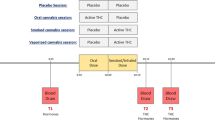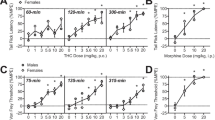Abstract
Rationale
The hyperphagic effect of ∆9-tetrahydrocannabinol (∆9THC) in humans and rodents is well known. However, no studies have investigated the importance of ∆9THC composition and any influence other non-∆9THC cannabinoids present in Cannabis sativa may have. We therefore compared the effects of purified ∆9THC, synthetic ∆9THC (dronabinol), and ∆9THC botanical drug substance (∆9THC-BDS), a ∆9THC-rich standardized extract comparable in composition to recreationally used cannabis.
Methods
Adult male rats were orally dosed with purified ∆9THC, synthetic ∆9THC, or ∆9THC-BDS, matched for ∆9THC content (0.34–2.68 mg/kg). Prior to dosing, subjects were satiated, and food intake was recorded following ∆9THC administration. Data were then analyzed in terms of hourly intake and meal patterns.
Results
All three ∆9THC substances tested induced significant hyperphagic effects at doses ≥0.67 mg/kg. These effects included increased intake during hour one, a shorter latency to onset of feeding and a greater duration and consumption in the first meal. However, while some differences in vehicle control intakes were observed, there were significant, albeit subtle, differences in pattern of effects between the purified ∆9THC and ∆9THC-BDS.
Conclusion
All ∆9THC compounds displayed classical ∆9THC effects on feeding, significantly increasing short-term intake whilst decreasing latency to the first meal. We propose that the subtle adjustment to the meal patterns seen between the purified ∆9THC and ∆9THC-BDS are due to non-∆9THC cannabinoids present in ∆9THC-BDS. These compounds and other non-cannabinoids have an emerging and diverse pharmacology and can modulate ∆9THC-induced hyperphagia, making them worth further investigation for their therapeutic potential.



Similar content being viewed by others
Abbreviations
- 2-AG:
-
2-Arachidonoylglycerol
- ∆9THC:
-
∆9-Tetrahydrocannabinol
- ∆9THC-BDS:
-
∆9-Tetrahydrocannabinol botanical drug substance
- ∆9THCA:
-
∆9-Tetrahydrocannabinolic acid
- ∆9THCV:
-
∆9-Tetrahydrocannabivarin
- AEA:
-
Anandamide
- ANOVA:
-
Analysis of variance
- CB1R:
-
Cannabinoid type 1 receptor
- CB2R:
-
Cannabinoid type 2 receptor
- CBC:
-
Cannabichromene
- CBD:
-
Cannabidiol
- CBG:
-
Cannabigerol
- CBN:
-
Cannabinol
- CBO:
-
Cannabitriol
- CNS:
-
Central nervous system
- eCB:
-
Endocannabinoid
- GPCR:
-
G-protein coupled receptor
- TRPA1:
-
Transient receptor potential A1
- TRPV1:
-
Transient receptor potential vanilloid 1
References
Akbas F, Gasteyger C, Sjödin A, Astrup A, Larsen TM (2008) A critical review of the cannabinoid receptor as a drug target for obesity management. Obes Rev 10:58–67
Beal JA (1994) Appetite effect of dronabinol. J Clin Oncol 12:1524–1525
Ben Amar M (2006) Cannabinoids in medicine: a review of their therapeutic potential. J Ethnopharmacol 105:1–25
Blundell JE, McArthur RA (1978) Behavioural flux and feeding: continuous monitoring of food intake and food selection, and the video-recording of appetitive and satiety sequences for the analysis of drug action. Anorectic agents: mechanism of action and tolerance. Raven Press, New York, pp 19–43
Brown AJ (2007) Novel cannabinoid receptors. Brit J Pharmacol 152:567–575
Burkey TH, Quock RM, Consroe P, Roeske WR, Yamamura HI (1997) ∆9-Tetrahydrocannabinol is a partial agonist of cannabinoid receptors in mouse brain. Eur J Pharmacol 323:R3–R4
Carr TP, Jesch ED, Brown AW (2008) Endocannabinoids, metabolic regulation, and the role of diet. Nutr Res 28:641–650
Dennis I, Whalley BJ, Stephens GJ (2008) Effects of ∆9-tetrahydrocannabivarin on [35S] GTPγS binding in mouse brain cerebellum and piriform cortex membranes. Brit J Pharmacol 154:1349–1358
De Petrocellis L, Vellani V, Schiano-Moriello A, Marini P, Magherini PC, Orlando P, Di Marzo V (2008) Plant-derived cannabinoids modulate the activity of transient receptor potential channels of ankyrin type-1 and melastatin type-8. J Pharmacol Exp Ther 325: 1007–1015
Dewey WL, Martin BR, May EL (1984) Cannabinoid stereoisomers: pharmacological effects. Handbook of stereoisomers: drugs in psychopharmacology. CPC Press, Boca Raton, pp 317–326
Di Marzo V, Bifulco M, De Petrocellis L (2004) The endocannabinoid system and its therapeutic exploitation. Nat Rev Drug Discov 3:771–784
Di Patrizio NV, Simansky KJ (2008) Activating parabrachial cannabinoid CB1 receptors selectively stimulates feeding of palatable foods in rats. J Neurosci 28:9702–9709
Elsohly MA, Slade D (2005) Chemical constituents of marijuana: the complex mixture of natural cannabinoids. Life Sci 78:539–548
Evans AT, Formukong E, Evans FJ (1987) Activation of phospholipase A2 by cannabinoids. Lack of correlation with CNS effects. FEBS Lett 211: 119–122
Gallate JE, McGregor IS (1999) The motivation for beer in rats: effects of ritanserin, naloxone and SR141716. Psychopharmacology 142:302–308
Gallate JE, Saharov T, Mallet PE, McGregor IS (1999) Increased motivation for beer in rats following administration of a cannabinoid CB1 receptor agonist. Eur J Pharmacol 370:233–240
Grotenhermen F (2006) Cannabinoids and the endocannabinoid system. Cannabinoids 1:10–14
Haney M, Rabkin J, Gunderson E, Foltin RW (2005) Dronabinol and marijuana in HIV + marijuana smokers: acute effects on caloric intake and mood. Psychopharmacology 181:170–178
Hao S, Avraham Y, Mechoulam R, Berry EM (2000) Low dose anandamide affects food intake, cognitive function, neurotransmitter and corticosterone levels in diet-restricted mice. Eur J Pharmacol 392:147–156
Herkenham M, Lynn AB, Johnson MR, Melvin LS, de Costa BR, Rice KC (1991) Characterization and localization of cannabinoid receptors in rat brain: a quantitative in vitro autoradiographic study. J Neurosci 11:563–583
Holland ML, Allen JD, Arnold JC (2008) Interaction of plant cannabinoids with the multidrug transporter ABCC1 (MRP1). Eur J Pharmacol 591:128–131
Izzo AA, Borrelli F, Capasso R, Di Marzo V, Mechoulam R (2009) Non-psychotropic plant cannabinoids: new therapeutic opportunities from an ancient herb. Trends Pharmacol Sci 30:515–527
Jones D (2008) End of the line for cannabinoid receptor 1 as an anti-obesity target? Nat Rev Drug Discov 7:961–962
Kirkham TC, Blundell JE (1984) Dual action of naloxone on feeding revealed by behavioural analysis: separate effects on initiation and termination of eating. Appetite 5:45
Kirkham TC, Williams CM (2001) Endogenous cannabinoids and appetite. Nutr Res 14:65–86
Lozovaya N, Min R, Tsintsadze V, Burnashev N (2009) Dual modulation of CNS voltage-gated calcium channels by cannabinoids: focus on CB1 receptor-independent effects. Cell Calcium 46:154–162
Ma YL, Weston SE, Whalley BJ, Stephens GJ (2008) The phytocannabinoid ∆9-tetrahydrocannabivarin modulates inhibitory neurotransmission in the cerebellum. Brit J Pharmacol 154:204–215
McHugh D, Tanner C, Mechoulam R, Pertwee RG, Ross RA (2008) Inhibition of human neutrophil chemotaxis by endogenous cannabinoids and phytocannabinoids: evidence for a site distinct from CB1 and CB2. Mol Pharmacol 73:441–450
Mechoulam R, Gaoni Y (1967) The absolute configuration of ∆1-tetrahydrocannabinol, the major active constituent of hashish. Tetrahedron Lett 12:1109–1111
Moore THM, Zammit S, Lingford-Hughes A, Barnes TRE, Jones PB, Burke M, Lewis G (2007) Cannabis use and risk of psychotic or affective mental health outcomes: a systematic review. Lancet 370:319–328
Neovius M, Teixeira-Pinto A, Rasmussen F (2007) Shift in the composition of obesity in young adult men in Sweden over a third of a century. Int J Obes 32:832–836
Pertwee RG (2007) The diverse CB1 and CB2 receptor pharmacology of three plant cannabinoids: ∆9-tetrahydrocannabinol, cannabidiol and ∆9-tetrahydrocannabivarin. Brit J Pharmacol 153:199–215
Pertwee RG (2008a) The diverse CB1 and CB2 receptor pharmacology of three plant cannabinoids: ∆9-tetrahydrocannabinol, cannabidiol and ∆9-tetrahydrocannabivarin. Brit J Pharmacol 153:199–215
Pertwee RG (2008b) Ligands that target cannabinoid receptors in the brain: from THC to anandamide and beyond. Addict Biol 13:147–159
Rao GK, Kaminski NE (2006) Cannabinoid-mediated elevation of intracellular calcium: a structure-activity relationship. J Pharmacol Exp Ther 317:820–829
Riedel G, Fadda P, McKillop-Smith PRG, Platt B, Robinson L (2009) Synthetic and plant-derived cannabinoid receptor antagonists show hypophagic properties in fasted and non-fasted mice. Brit J Pharmacol 156:1154–1166
Ryan D, Drysdale AJ, Lafourcade C, Pertwee RG, Platt B (2009) Cannabidiol targets mitochondria to regulate intracellular Ca2+ levels. J Neurosci 29:2053
Takeda S, Misawa K, Yamamoto I, Watanabe K (2008) Cannabidiolic acid as a selective cyclooxygenase-2 inhibitory component in cannabis. Drug Metab Dispos 36:1917–1921
Thomas A, Stevenson LA, Wease KN, Price MR, Baillie G, Ross RA, Pertwee RG (2005) Evidence that the plant cannabinoid ∆9-tetrahydrocannabivarin is a cannabinoid CB1 and CB2 receptor antagonist. Brit J Pharmacol 7:917–926
Weston SE, Williamson EM, Constanti A, Stephens GJ, Whalley BJ (2006) Tetrahydrocannabivarin exhibits anticonvulsant effects in a piriform cortical brain slice model of epileptiform activity. Proceedings of the BPS at http://www.pa2online.org/abstract/abstract.jsp?abid=28533
Whalley BJ, Wilkinson JD, Williamson EM, Constanti A (2004) A novel component of cannabis extract potentiates excitatory synaptic transmission in rat olfactory cortex in vitro. Neurosci Lett 365:58–63
Williams CM, Kirkham TC (1999) Anandamide induces overeating: mediation by central cannabinoid CB1 receptors. Psychopharmacology 143:315–317
Williams CM, Kirkham TC (2002) Observational analysis of feeding induced by ∆9-THC and anandamide. Physiol Behav 76:241–250
Williams CM, Kirkham TC (in press) Accumbens shell infusion of the endocannabinoid 2-AG increases food intake by advancing meal-onset in free-feeding rats. Psychopharmacology
Williams CM, Rogers PJ, Kirkham TC (1998) Hyperphagia in pre-fed rats following oral ∆9-THC. Physiol Behav 65:343–346
Williamson EM, Evans FJ (2000) Cannabinoids in clinical practice. Drugs 60:1303–1314
Wirth PW, Watson ES, ElSohly M, Turner CE, Murphy JC (1980) Anti-inflammatory properties of cannabichromene. Life Sci 26:1991–1995
Zhu HJ, Wang JS, Markowitz JS, Donovan JL, Gibson BB, Gefroh HA, Devane CL (2006) Characterization of P-glycoprotein inhibition by major cannabinoids from marijuana. J Pharmacol Exp Ther 317:850–857
Acknowledgements
This research was supported in part by the University of Reading Research Endowment Trust Fund (to JAF). The authors thank Mr. Trevor Jenkinson and his team for technical assistance and GW Pharmaceuticals for the kind gifts of purified ∆9THC and ∆9THC-BDS.
Author information
Authors and Affiliations
Corresponding author
Additional information
Ethical compliance
All procedures were performed in compliance with the requirements of the United Kingdom Animals (Scientific Procedures) Act 1986 and all other applicable laws and standards in the U.K.
This research was supported in part by the University of Reading Research Endowment Trust Fund (to JAF).
Rights and permissions
About this article
Cite this article
Farrimond, J.A., Hill, A.J., Whalley, B.J. et al. Cannabis constituents modulate ∆9-tetrahydrocannabinol-induced hyperphagia in rats. Psychopharmacology 210, 97–106 (2010). https://doi.org/10.1007/s00213-010-1821-z
Received:
Accepted:
Published:
Issue Date:
DOI: https://doi.org/10.1007/s00213-010-1821-z




